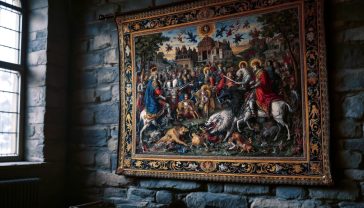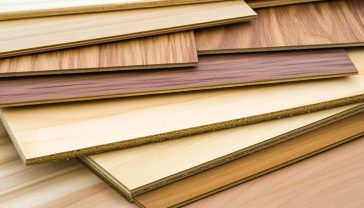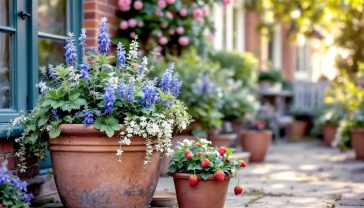The Great British Glow-Up: Your Guide to Choosing and Loving a Garden Chiminea
Warm up your garden evenings with the perfect chiminea. Explore the 4 main types—clay, cast iron, steel, and aluminium—and get expert UK advice on safety and care.
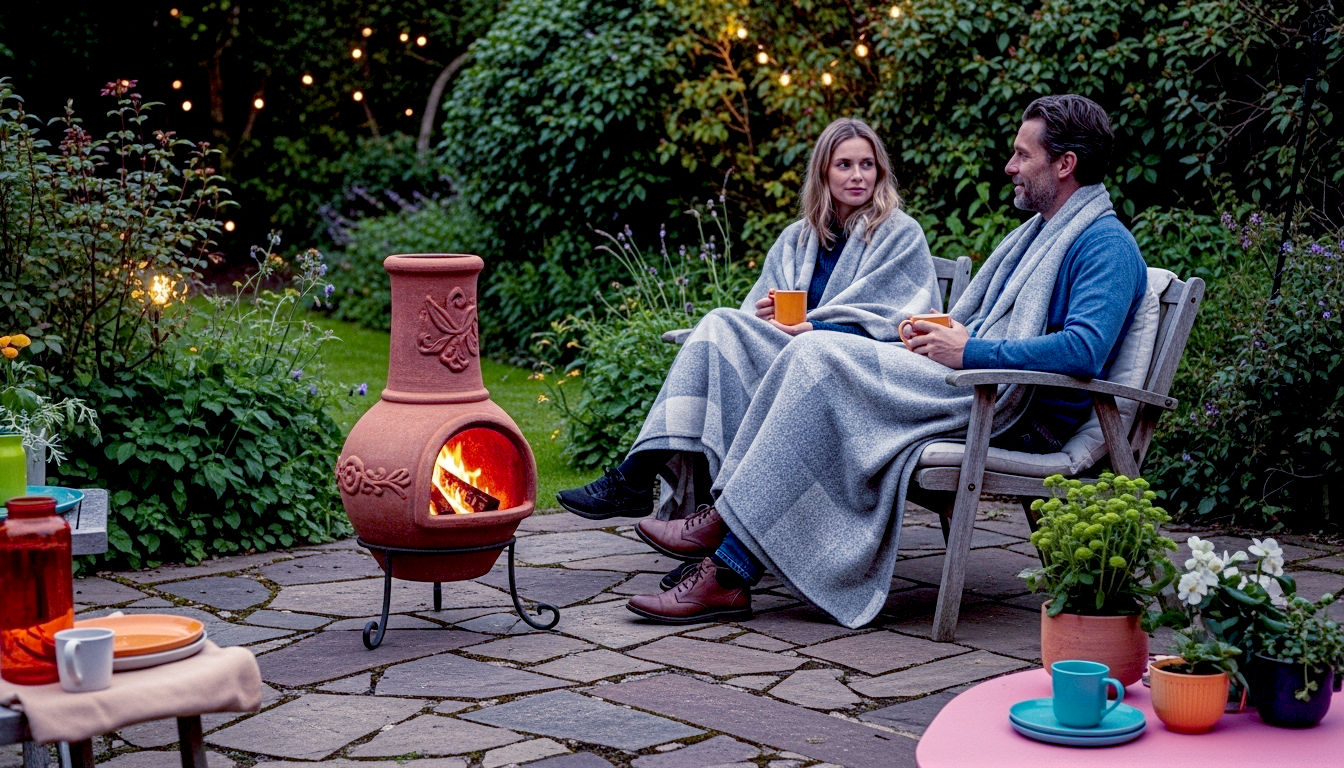
This post may contain affiliate links. If you make a purchase through these links, we may earn a commission at no additional cost to you.
There’s a special kind of magic to a British garden in the evening. The scent of damp earth and late-blooming roses, the sound of a blackbird’s final song, and the gentle fade of daylight. But then, the chill arrives. It’s that familiar, creeping cold that sends us scurrying back indoors, cutting short countless lovely evenings.
But what if you didn’t have to? What if you could bottle the warmth of a cosy fireplace and bring it out onto your patio?
That’s the promise of the chiminea. More than just a patio heater, this charming, pot-bellied fireplace has been warming up British gardens for years. It’s the difference between a hasty retreat and lingering for hours under the stars, glass in hand, chatting with friends and family. It turns your garden into a year-round living room.
Whether you’ve got a tiny city balcony or a sprawling country lawn, there’s a chiminea for you. But with so many types, from rustic clay to sleek steel, how do you choose? Don’t worry. We’re here to walk you through everything. This is your definitive guide to finding the perfect chiminea to warm your garden, keep you safe, and make your neighbours peek over the fence with envy.
What on Earth is a Chiminea, Anyway?
Before we dive into the different types, let’s get to know this brilliant bit of kit. A chiminea (pronounced chim-in-AY-ah) is basically a freestanding, front-loading fireplace with a tall, narrow chimney. Its design is beautifully simple and incredibly clever.
The story starts hundreds of years ago in Mexico. Traditionally, they were made from terracotta clay and used for baking bread and keeping homes warm. The design was perfected over centuries. The round body, or ‘belly’, lets you build a good fire, while the chimney funnels smoke up and away from you. This is a huge advantage over smoky, open fire pits that can have you constantly shuffling your chair to avoid a face full of fumes.
The clay also absorbs heat and radiates it outwards, creating a lovely, gentle warmth that spreads around your seating area. In the 1990s, they started appearing in British garden centres, and we’ve loved them ever since. They bring a touch of rustic, holiday charm to our gardens, and, most importantly, they let us enjoy our outdoor spaces for longer.
The Big Four: Unpacking the Different Types of Chiminea
Chimineas aren’t a one-size-fits-all deal. They come in four main materials, and each one has its own personality, perks, and quirks. Understanding these is the key to finding your perfect match.
1. The Traditionalist: Clay Chimineas
This is the classic, the original, the one that probably pops into your head when you think ‘chiminea’. Made from terracotta or other clays, these have a wonderfully rustic, authentic look that fits beautifully into traditional cottage gardens or adds a warm, Mediterranean touch to a modern patio.

Large La Hacienda Bennito Clay Chimenea – Tall Traditional Mexican Log Burner (BBQ Terracotta Fire Pit, Garden Patio Heater Stove)

Gardeco Azteca Mexican Chimney, Yellow, X-Large

CHARLES BENTLEY Outdoor, Garden, Patio, Large Terracotta Clay Chimenea, Patio Heater, Easy To Assemble, Rustic Finish, Lizard Design, Burns Wood, Clay And…
Think of a clay chiminea as a giant, hollow terracotta pot that breathes heat. The clay itself soaks up the warmth from the fire and then radiates it out gently and evenly. It’s a soft, comforting heat, perfect for huddling around on a cool evening.
The Good Bits (Pros):
The Not-So-Good Bits (Cons):
Best for: Someone who loves the traditional look, wants a gentle, radiant heat, and doesn’t mind a bit of careful maintenance. Perfect for creating a cosy, rustic vibe.
2. The Powerhouse: Cast Iron Chimineas
If a clay chiminea is a rustic charmer, a cast iron one is a rugged, powerful workhorse. Made from heavy, moulded iron, these are built to last and to pump out some serious heat. They often come in a classic black finish and can have more intricate, ornate designs than clay models.

GARDEBRUK® Chiminea Cast Iron Patio Stove with Cover & Poker | La Hacienda Mexican Log Burner | Outdoor Garden Fire Pit | Terrace Fireplace | Wood Burning |…

CHARLES BENTLEY Outdoor, Garden, Patio, Extra-Large Open Bowl Mesh Cast Iron and Steel Chiminea, Patio Heater, Easy To Assemble, Grill And Poker Included,…

Tall Modern Cast Iron La Hacienda Cuba Chiminea, Log Burner (Large Garden Patio Heater, Fire Pit Chiminea)
A cast iron chiminea works like a classic wood-burning stove. The metal gets incredibly hot and radiates a powerful, intense heat over a wide area. If you want to warm up a larger patio and keep a bigger group of people toasty, cast iron is a fantastic choice.
The Good Bits (Pros):
The Not-So-Good Bits (Cons):
Best for: People with larger gardens who want maximum heat and durability. Ideal for those who love to entertain outdoors and fancy doing a bit of cooking on the fire.
3. The Modernist: Steel Chimineas
Steel chimineas are the new kids on the block. They offer a more contemporary, minimalist look and are a great, practical choice for modern gardens. They are much lighter than cast iron and often more affordable, making them a very popular option.

La Hacienda Barola Contemporary Steel Chiminea Patio Heater Outdoor Black

CHARLES BENTLEY 129cm Outdoor, Garden, Patio, Black Powder Coated Steel Modern Patio Heater, Chimenea, Wood And Charcoal Burner, With Poker, Log Storage,…

Log Barn Fire Chiminea for Garden (43 x 43 x 118 cm). Black Steel Log Burner Outdoor with Poker. Durable, Easy to Assemble, Lightweight Wood Burner Outdoor -…
Think of them as a lighter, more streamlined version of their cast iron cousins. They heat up very quickly, providing almost instant warmth, but they also cool down quickly once the fire is out because the metal is thinner. They come in all sorts of sleek shapes and sizes, from tall, slender columns to bold, geometric designs.
The Good Bits (Pros):
The Not-So-Good Bits (Cons):
Best for: Anyone looking for a modern, stylish, and practical garden heater. Perfect for those who want a lightweight, low-fuss option at a reasonable price.
4. The Premium Choice: Cast Aluminium Chimineas
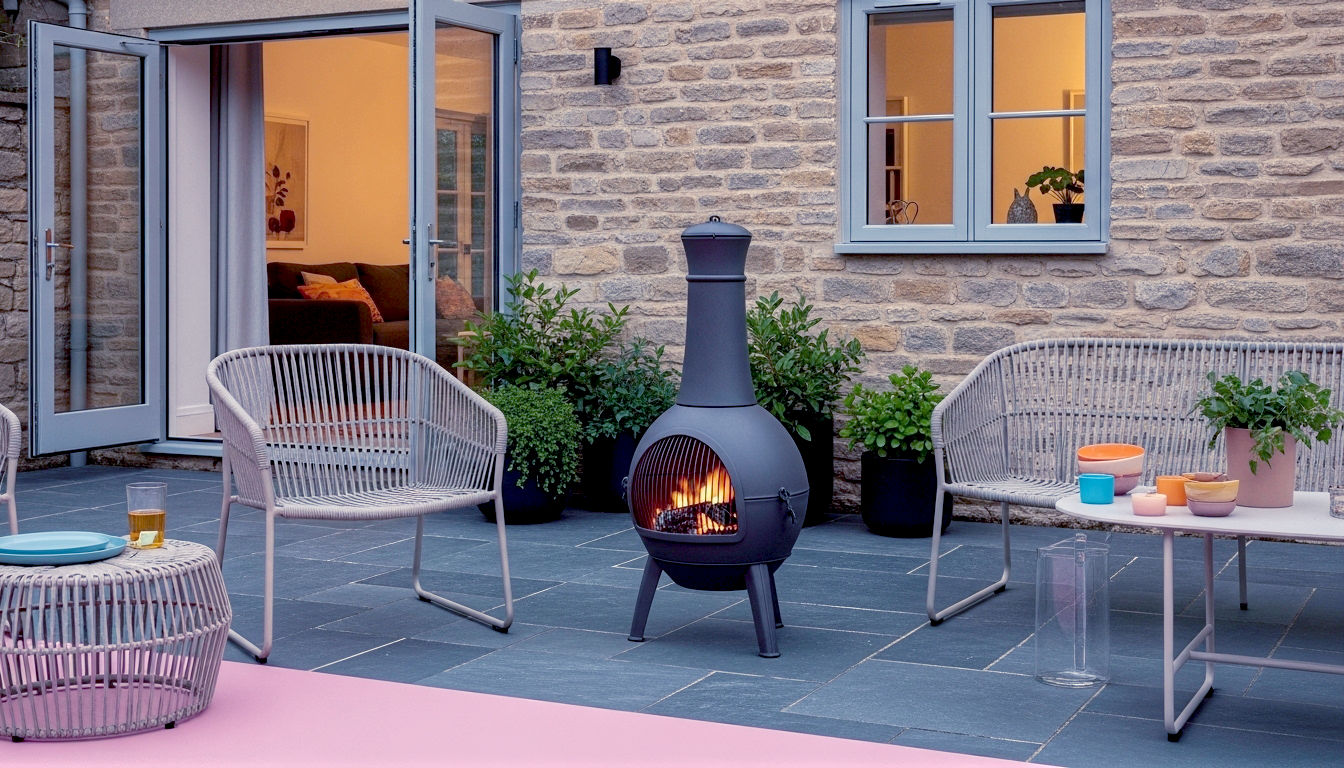
Cast aluminium is the top-tier option. It takes the best bits of cast iron and steel and rolls them into one fantastic, albeit more expensive, package. They look very similar to cast iron models, often with the same classic shapes and finishes (like bronze or black), but they have a secret weapon: they don’t rust.
This makes them incredibly low-maintenance and perfectly suited to the damp British climate. They are also much lighter than cast iron, making them easier to move. They heat up quickly and radiate heat very effectively.
The Good Bits (Pros):
The Not-So-Good Bits (Cons):
Best for: Someone who wants the power and look of a cast iron chiminea without the weight and rust issues. It’s the “buy it once, buy it right” option for those who are happy to invest in a top-quality, low-maintenance garden heater.
How to Choose the Right Chiminea for Your British Garden
Okay, you know the four main players. Now, how do you pick your winner? It’s about matching the chiminea to your garden, your lifestyle, and your budget. Ask yourself these questions.
What size is your garden?
- Small Patio or Balcony: A small clay or steel chiminea is perfect. They don’t take up much space and provide enough heat for a cosy corner. A large cast iron model would be overwhelming and potentially unsafe in a tight space.
- Medium-Sized Garden: You have more options. A medium to large chiminea of any type will work well. Think about how many people you usually have over.
- Large Garden: If you have a large, open patio and love hosting big gatherings, a large cast iron or cast aluminium chiminea is your best bet. They have the power to throw heat over a much wider area.
What’s your style?
- Country Cottage or Rustic: A traditional clay chiminea is a natural fit. Its earthy tones and handmade feel will complement your garden perfectly.
- Modern and Minimalist: Look for a sleek steel chiminea. Simple shapes in black or grey will look fantastic against modern paving and fencing.
- Classic and Traditional: An ornate cast iron or cast aluminium chiminea will feel right at home. They have a timeless, elegant look.
How much maintenance are you prepared to do?
- “I just want it to work!”: Go for cast aluminium. It requires almost no maintenance beyond cleaning out the ash.
- “I don’t mind a bit of TLC.”: Steel or cast iron are great choices. You’ll just need to be disciplined about using a cover and occasionally touching up the paintwork.
- “I’m a careful, patient person.”: If you’re happy to cure it properly and protect it religiously from bad weather, a clay chiminea will reward you with its unique charm.
Getting Started: How to Use Your Chiminea Safely
A chiminea is a contained fire, which makes it much safer than an open fire pit. But it’s still a fire, and it needs respect. Following these safety rules is non-negotiable.
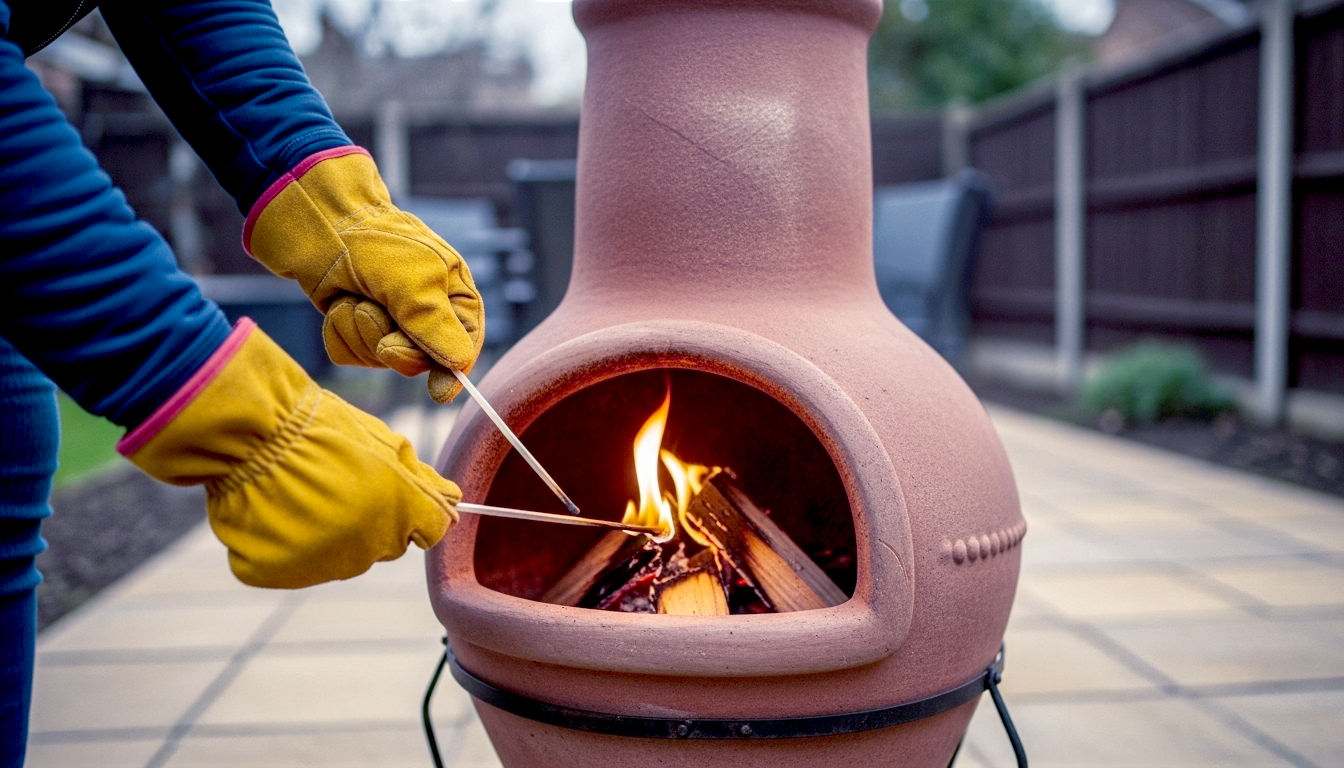
Curing Your New Clay Chiminea: The Golden Rule
If you buy a clay chiminea, you must do this before you have your first proper fire. Curing is the process of gradually building up heat inside the chiminea to bake the clay, making it stronger and much more resistant to cracking. It’s easy, but it takes patience.
- Start with Sand: Put a layer of sand or lava stones in the bottom of the chiminea’s belly. This protects the clay from the direct, intense heat of the flames.
- Fire 1: The Kindling Fire. Light a very small fire using only a few bits of kindling. Let it burn out and cool down completely.
- Fire 2: A Bit Bigger. The next day, light another small fire, a little bigger than the first. Again, let it burn out and cool down fully.
- Repeat 3-5 Times: Keep doing this, making each fire slightly bigger and hotter than the last. You’re teaching the clay how to handle the heat.
- Ready to Go! After several small fires, your chiminea is cured and ready for a normal-sized fire.
Never, ever throw a huge log into a brand-new clay chiminea and light it. It will almost certainly crack.
Location, Location, Location
Where you put your chiminea is crucial for safety.
- Solid Ground: Place it on a flat, stable, non-flammable surface like stone paving slabs or a gravel area. Never put it directly on a wooden deck or lawn, as the heat can cause scorching or a fire. You can buy special heatproof mats for decking.
- Keep Your Distance: Make sure it’s a safe distance away from your house, fences, sheds, trees, and overhanging branches. Check the manufacturer’s instructions, but a few metres is a good rule of thumb.
- Consider Your Neighbours: Be mindful of where the smoke from the chimney will go. Try to position it so it doesn’t blow directly into your neighbour’s windows or garden.
Fuelling the Fire: What to Burn
The right fuel makes for a better, safer, and less smoky fire.
- Best: Kiln-dried hardwood like oak, ash, or beech is the absolute best. It’s dry, so it burns cleanly with lots of heat and minimal smoke.
- Good: Seasoned logs are also good, as long as they have been properly dried for at least a year.
- Avoid: Never burn wet, green wood. It will create a huge amount of thick, unpleasant smoke. Also avoid pressure-treated wood, pallets, or any rubbish, as these can release toxic fumes.
- Smokeless Zones: Be aware that many towns and cities in the UK are Smoke Control Areas. If you live in one, you are legally required to burn only authorised smokeless fuels. Check your local council’s website to find out if this applies to you.
Putting it Out Safely
When the evening is over, don’t just leave the fire to smoulder.
- Allow the fire to die down naturally.
- You can then carefully use sand to smother the embers.
- NEVER pour a bucket of cold water onto a hot chiminea, especially a clay or cast iron one. The sudden temperature shock can cause it to crack or shatter.
Looking After Your Chiminea Through the British Seasons
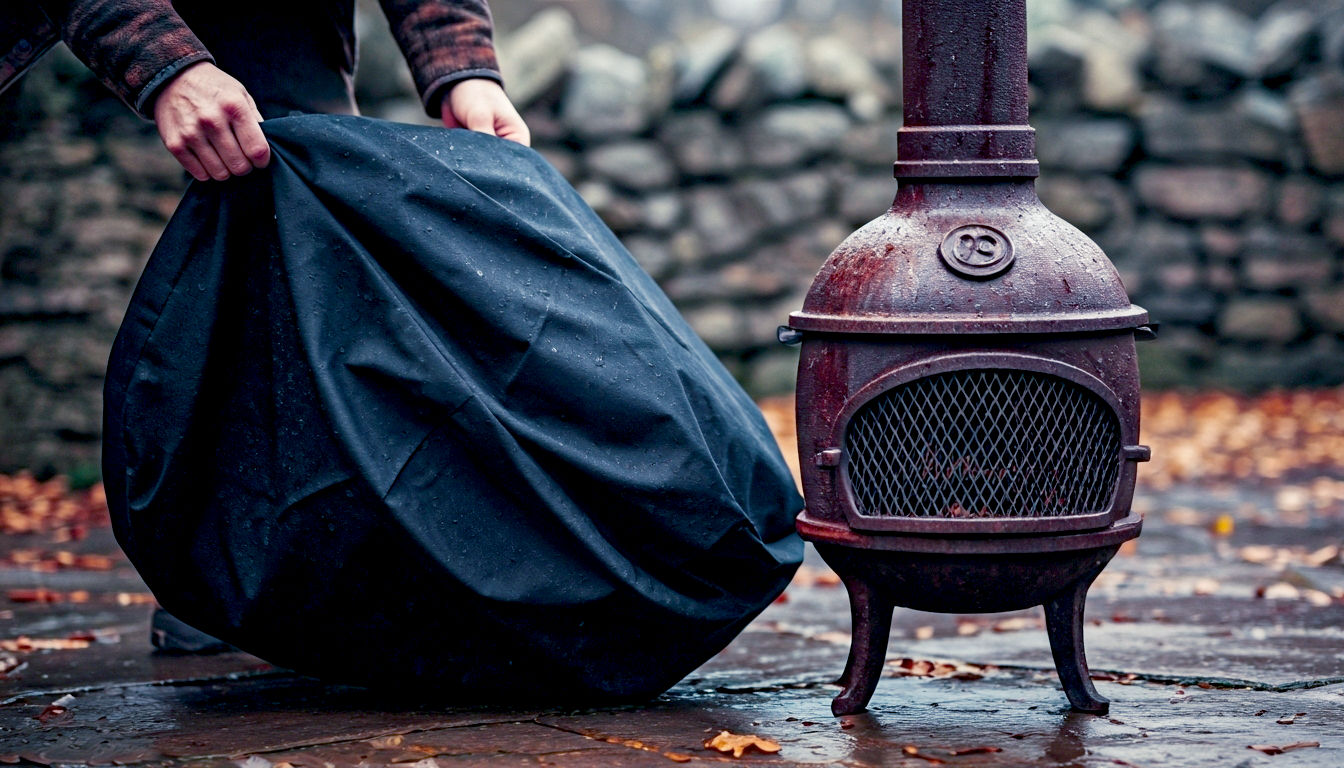
A little bit of care will keep your chiminea looking great and working perfectly for years.
- Clean Out the Ash: Before each use, scoop out the old ash from the belly. A big build-up of ash can block airflow and make the fire burn less efficiently.
- The All-Important Cover: This is the single best thing you can do for your chiminea. A waterproof, breathable cover will protect it from rain and frost, preventing cracks in clay models and stopping rust on metal ones. Put the cover on as soon as the chiminea has fully cooled down.
- Clay Care: It’s a good idea to re-seal the outside of a clay chiminea with a special sealant every year. This helps to make it more water-resistant.
- Metal Maintenance: If you spot a bit of rust on your cast iron or steel chiminea, don’t panic. Just sand the rusty spot down with some wire wool and touch it up with a lick of high-temperature barbecue or stove paint.
Chiminea vs. Fire Pit: The Garden Grudge Match
This is a common question. Both will warm you up, but they do it in different ways.
| Feature | Chiminea | Fire Pit |
|---|---|---|
| Heat | Directional. Radiates heat from the front opening. Good for focused warmth. | 360-degree. Everyone can gather around it. |
| Smoke | Contained. The chimney directs smoke up and away. | Open. Smoke can blow in any direction, often into people’s faces. |
| Safety | Safer. The fire is enclosed, so sparks are less likely to escape. | Less Safe. An open flame needs more careful supervision. |
| Footprint | Smaller. Generally takes up less space. | Larger. Needs more clearance and a bigger footprint. |
| Cooking | Good for small-scale grilling with the right accessories. | Excellent for toasting marshmallows and barbecue-style cooking. |
| Aesthetics | A strong, sculptural feature. | Creates a central, campfire-like focal point. |
The Verdict? If you value safety, hate having smoke in your eyes, and want a stylish feature for a smaller space, a chiminea is probably the better choice. If you have a large area and love the communal, all-around feel of a campfire, a fire pit might be for you.
Your Garden’s Warmest Welcome
Choosing a chiminea is about more than just buying a heater. It’s an investment in your home, your garden, and your lifestyle. It’s about deciding to spend more time outdoors, making memories with the people you love.
Whether you fall for the rustic charm of clay, the raw power of cast iron, the sleek lines of steel, or the clever, low-maintenance design of cast aluminium, you’re bringing a warm, glowing heart into your garden. It will become the focal point for quiet morning coffees, lazy weekend lunches that stretch into the evening, and cosy nights spent stargazing.
So, go on. Give your garden the glow-up it deserves. That British chill doesn’t stand a chance.
Further Reading & Resources
- Good Homes – Garden Heating Advice: https://www.goodhomesmagazine.com/garden/outdoor-heating-options/
- GOV.UK – Smoke Control Areas Explained: https://www.gov.uk/smoke-control-area-rules
- Gardeningetc – Chiminea ideas and inspiration: https://www.gardeningetc.com/advice/what-is-a-chiminea

